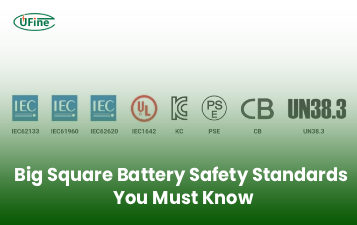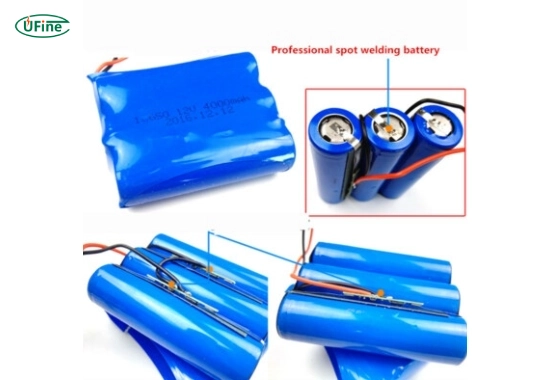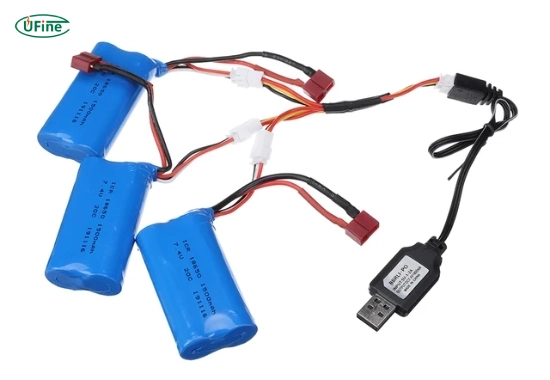
- Part 1. What is a 3S LiPo battery?
- Part 2. Why does "3S" matter for performance?
- Part 3. Voltage fundamentals: nominal vs. full-charge voltage
- Part 4. Difference between 2S and 3S LiPo battery
- Part 5. Charging a 3S LiPo battery: Best practices
- Part 6. Safe usage tips for 3S LiPo batteries
- Part 7. How to tell if a 3S LiPo battery is fully charged?
- Part 8. How to safely parallel charge 3S LiPo batteries?
- Part 9. Choosing the right 3S LiPo for your application
- Part 10. How long does a 3S LiPo battery last?
- Part 11. FAQs about 3S LiPo battery
What is a 3S LiPo battery, and why does it matter in high-performance RC, drone, and FPV systems? A 3S LiPo battery is a three-cell lithium polymer battery that delivers powerful energy in a compact and lightweight form. It is one of the most popular battery types used in the hobby world thanks to its balance of voltage, weight, and compatibility.
In this in-depth guide, we will explore the fundamentals of voltage, the differences between 2S and 3S LiPo batteries, safe handling practices, how to parallel charge 3S packs, and much more. To maximize performance, efficiency, and safety in your builds, continue reading.
Part 1. What is a 3S LiPo battery?
A 3S LiPo battery consists of three lithium polymer cells connected in series. Each cell has a nominal voltage of 3.7 volts, which gives the battery a total nominal voltage of 11.1 volts. When fully charged, each cell reaches 4.2 volts, resulting in a fully charged voltage of 12.6V.
These batteries are commonly used in:
- RC cars and trucks
- Racing drones and quadcopters
- Airplanes and gliders
- FPV systems
- Robotics and DIY electronics
The “S” in “3S” refers to the number of cells in series configuration. More series cells mean greater voltage, which directly translates to more power and speed.
Part 2. Why does “3S” matter for performance?
The number of cells in a LiPo battery determines its overall voltage output, which is a critical factor in how your electronics perform. A higher voltage allows motors to spin faster, produce more torque, and deliver better throttle response.
Here is why 3S is often considered a performance sweet spot:
- It provides a significant power boost over 2S systems without being as demanding as 4S or 6S.
- Many electronic speed controllers (ESCs) and motors support 3S as a standard, making it widely compatible.
- It offers a good balance between weight and power, especially for drones and RC cars that need both speed and maneuverability.
In short, 3S enables better acceleration, higher speeds, and more efficient power delivery than lower-voltage packs.
Part 3. Voltage fundamentals: nominal vs. full-charge voltage
Understanding how voltage behaves in LiPo batteries is essential for safe use and optimal performance.
| Voltage Type | Value per Cell | 3S Total Voltage |
|---|---|---|
| Nominal Voltage | 3.7V | 11.1V |
| Fully Charged Voltage | 4.2V | 12.6V |
| Storage Voltage | 3.8V | 11.4V |
| Minimum Safe Voltage | 3.0V | 9.0V |
- Nominal voltage is the average voltage during regular use.
- Fully charged voltage is the maximum safe voltage a cell can reach.
- Storage voltage is the ideal level for long-term storage, which helps preserve battery life.
- Minimum safe voltage must not be crossed, as it can damage the battery and reduce its capacity permanently.
Monitoring voltage is vital. Dropping below 3.0V per cell or overcharging beyond 4.2V can lead to performance loss, swelling, or even fire.
Part 4. Difference between 2S and 3S LiPo battery
Many beginners wonder about the difference between 2S and 3S LiPo batteries. The primary difference lies in the voltage, which affects speed, power, and performance.
| Feature | 2S LiPo Battery | 3S LiPo Battery |
|---|---|---|
| Cells in Series | 2 | 3 |
| Nominal Voltage | 7.4V | 11.1V |
| Fully Charged Voltage | 8.4V | 12.6V |
| Common Capacity Range | 1000mAh to 6000mAh | 1300mAh to 6000mAh |
| Weight (example 2200mAh) | Around 170 grams | Around 210 grams |
| Discharge Rate (C) | 20C to 60C | 20C to 100C |
| Typical Use | Beginners, light RC models | Intermediate to advanced users |
| Speed & Power Output | Lower | Higher |
A 2S battery is often used in beginner drones and RC cars due to its manageable speed and lower stress on electronics. A 3S battery increases voltage and delivers more punch, making it ideal for users who want faster acceleration and better climbing power.
Part 5. Charging a 3S LiPo battery: Best practices
Charging a LiPo battery is not like charging your phone. LiPo packs are sensitive and need to be handled with care.
Here is how to safely charge a 3S LiPo battery:
- Use a balance charger: This type of charger ensures each cell in the battery is charged evenly.
- Set the charger to 3S mode: Confirm that the battery type is set to LiPo and the cell count is three.
- Charge at 1C rate: For example, a 2200mAh battery should be charged at 2.2A.
- Connect balance lead and main lead: Both must be plugged into the charger for accurate charging.
- Place the battery in a fireproof LiPo bag: Safety first.
- Monitor during charging: Never leave LiPo batteries unattended while charging.
Charging above 1C can reduce the lifespan of the battery unless the manufacturer specifically allows it.
Part 6. Safe usage tips for 3S LiPo batteries
LiPo batteries are powerful, but they require safe handling. Here are some essential safety tips:
- Never discharge below 3.0V per cell
- Do not puncture or crush the battery
- Avoid charging when the battery is hot
- Always store batteries at storage voltage
- Inspect regularly for swelling or damage
- Use a fireproof container for storage and charging
Also, avoid short-circuiting the battery by ensuring that the terminals never touch each other or conductive materials.
Part 7. How to tell if a 3S LiPo battery is fully charged?
To determine if a 3S LiPo battery is fully charged:
- Use a digital voltage checker or balance charger
- A fully charged 3S battery will read 12.6V total
- Each individual cell should be around 4.20V
If any cell is significantly below this, the battery may be unbalanced and should be recharged using the balance mode to correct the issue.
Part 8. How to safely parallel charge 3S LiPo batteries?
Parallel charging allows you to charge multiple 3S batteries at once using a parallel board. This method is efficient but must be performed with great caution.
- Ensure all batteries are at similar voltage levels
- All batteries must be within 0.1 volts of each other.
- Large voltage differences can cause dangerous current surges.
- Use a quality parallel charging board
- The board should support 3S batteries.
- Make sure it includes fuses or built-in protection features.
- Connect the batteries to the parallel board
- Plug in each battery’s main power leads.
- Also connect their balance leads to the board.
- Connect the board to the charger
- Use the charger’s main output and balance lead to connect to the board.
- Set the charger correctly
- Battery type: LiPo
- Cell count: 3S
- Charge current: Total capacity × 1C
- Example: Three 2200mAh packs = 2200 × 3 × 1C = 6.6A
- Monitor the process
- Closely observe the first 10 minutes of charging.
- Watch for any abnormal behavior or heat.
- Remove batteries when done
- Disconnect the batteries safely.
- Store them at proper storage voltage.
Warning: Never parallel charge batteries of different cell counts (e.g., 3S and 4S) or vastly different capacities.
Part 9. Choosing the right 3S LiPo for your application
When selecting a 3S LiPo battery, consider these factors:
- Capacity in mAh: Higher capacity = longer run time, but also more weight.
- C Rating: Determines how quickly the battery can discharge. A 2200mAh 30C battery can deliver 66A of continuous current.
- Size and weight: Make sure it fits your drone or RC chassis.
- Connector type: XT60, Deans, EC3, or others must match your ESC.
- Brand reputation: Stick to trusted manufacturers for quality and safety.
For instance, if you are flying a 5-inch racing drone, a 3S 1300mAh 75C battery is a common choice.
Part 10. How long does a 3S LiPo battery last?
The lifespan of a LiPo battery is affected by several factors:
- How deep you discharge it
- How fast you charge it
- Temperature during use
- Storage habits
A well-maintained 3S LiPo can last 150 to 300 cycles. If abused, it may fail after just 30 to 50 cycles. Always store your battery at 3.8V per cell, avoid high temperatures, and never over-discharge.
Part 11. FAQs about 3S LiPo battery
What is a 3S LiPo battery?
A 3S LiPo battery is a lithium polymer battery with three cells in series, offering a nominal voltage of 11.1V and a fully charged voltage of 12.6V. It is widely used in RC hobbies for its power and efficiency.
What is the difference between 2S and 3S LiPo battery?
The main difference is voltage. A 2S battery has 7.4V nominal, while a 3S has 11.1V, providing more power and speed. However, a 3S is heavier and requires more robust electronics.
How do I safely charge a 3S LiPo battery?
Use a balance charger, set it to 3S mode, charge at 1C, and never leave the battery unattended. Always charge in a fire-safe area using a LiPo bag.
Can I charge multiple 3S batteries at once?
Yes, you can parallel charge 3S batteries if they are at similar voltages (within 0.1V), using a parallel board and proper charger settings.
What is the fully charged voltage of a 3S LiPo battery?
A 3S LiPo battery is fully charged at 12.6 volts, with each cell at 4.2 volts.
Related Tags:
More Articles

Big Square Battery Safety Standards You Must Know
Learn key safety standards for big square batteries to avoid fire risks, shipping delays, and compliance issues in EV, industrial, and energy storage projects.
Big Square Battery Applications in Solar & Industrial Equipment
Big square batteries deliver high capacity, stable output, and long life for solar, industrial, and backup power. Explore key uses and advantages.
Big Square Battery vs Cylindrical Battery: Complete 2025 Guide for EVs, ESS & Industrial Devices
Choosing the right battery is key for designers and engineers. Compare big square vs cylindrical batteries to find the best fit for your application.
How to Choose the Right Big Square Battery for Your Device?
If you’re choosing a big square battery for EVs, solar, or mobility devices, this guide helps you pick the right solution for real-world needs.
Big Square Battery Complete Guide: Types, Uses & Buying Tips
If you are choosing a big square lithium battery for EVs, solar, RVs, or AGVs, this guide helps you select the right NMC, LFP, or LTO solution with examples.





